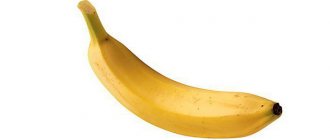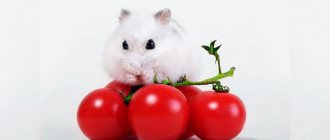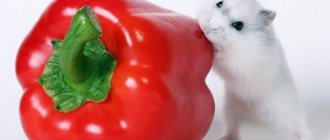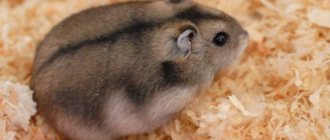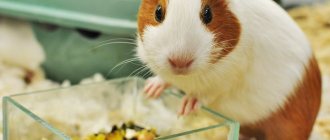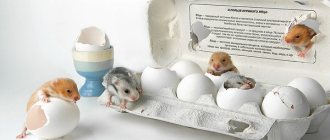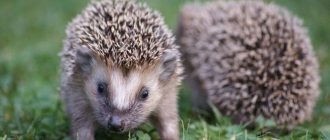Veterinarians recommend adding fresh, juicy fruits to the diet of captive rodents.
In this article, we will consider whether hamsters can have apples, whether it is worth giving pets dried fruits, whether to peel fresh ones, and which varieties to prefer. Let’s say right away that you can and should give your hamster an apple; it will only bring benefits to your pet. However, there are some points that need to be taken into account before treating the animal with new food.
Why you shouldn't give too much
The idea of whether to feed a hamster an apple is no longer in doubt - these fruits should be in their diet. If used in moderation, no substances were found in them that could be harmful. Therefore, it is necessary to adhere to the advice recommended by veterinarians. The product must be fresh and not treated with harmful chemicals. It is best if the apples are from your own garden or purchased at the market from trusted sellers. Stores sell fruits with special mixtures applied to them so that they do not spoil or wither. This product will not be beneficial for your pet. “Wormy” fruits are considered especially clean.
It is necessary to give a small amount and no more often than every one or two days. This is not the main food, but rather serves as a dessert or complementary food. His main diet consists of special grain mixtures.
Excessive consumption of fruits can cause increased gas formation, stomach problems, excess weight, and even increased blood sugar levels.
Don't forget that fruit spoils soon. Make sure that the leftovers do not end up among the animal’s main food and that rotting does not begin, which will have a detrimental effect on the small organism and on its other food products. Check periodically to see if he has buried pieces “in reserve” somewhere in his house.
Dried fruits for hamsters
In winter, instead of not very healthy fresh fruits from the store, it is better to occasionally give your hamster dried fruits, but also in dosed doses. Such treats are often offered as treats and rewards during training. Ideally, of course, prepare them yourself using a special dryer or oven. The raw materials should not be too sweet - apples, pears, viburnum, cranberries, lingonberries.
Article on the topic: Can hamsters have fresh cucumbers, at what age and how often?
It is worth considering the characteristics of the pet and its predisposition to diabetes. So, in the diet of the Campbell breed they often do without dried fruits; the Djungarian hamster is given less sweet treats, for example, apple slices. Syrian hamster and other species can be given raisins, homemade banana chips and a small piece of prunes 1-2 times a week.
Features of introduction into the diet
The hamster must be given fully ripe apples. Not too ripe fruits cause intestinal upset. They cannot digest a lot of fiber. Such food is too heavy for their digestive system.
The age of the animal should be taken into account. It is better for lactating females, babies under one month and older rodents to avoid such food.
Dried apples are not inferior in quality to fresh ones, however, they contain a little juicy liquid. Therefore, before eating, they should be kept in warm water for several hours.
Baked and stewed fruits are not recommended; it is better not to risk it.
Beneficial features
Apple is a low-allergenic fruit. It is good to eat to:
- strengthen the immune system (due to the high content of vitamins);
- maintain a normal cardiovascular system (potassium will help with this);
- increase hemoglobin (this fruit contains a lot of iron);
- improve blood composition (this indicator is affected by copper, zinc and other trace elements).
These familiar fruits also contain a lot of fiber, which has a positive effect on intestinal motility. Rodents should also be fed apples to prevent the development of tumors.
Which variety to choose and whether the fruits need to be processed
Sweet varieties are much more attractive to rodents, but they contain a huge percentage of sugar (approximately 15%). Therefore, it is better to choose sweet and sour varieties, because excess acid or sucrose is harmful to their body.
To avoid poisoning, before giving it to your hamster, you need to wash it thoroughly under running water. If the products are from your garden, then give apples with peel. And if purchased, after washing, cut off the skin and put in water for 8-10 hours, and you can offer them to the animal. It is also necessary to clear the slices of seeds. They contain poisonous hydrocyanic acid.
Plant food
Fruits in syrup, compote berries, and jam should not be offered to rodents. Any preserved food is prohibited because it contains sugar and salt. Raw seasonal fruits are preferred for feeding. Some of them are placed in the cage boiled (zucchini, beets, carrots, pumpkin). The cooking time in this case is minimal. The water is not salted.
If fresh fruits and vegetables are purchased at the store, it is better to cut off the skin (it often contains pesticides). For home harvest, this step is not necessary. Plant foods, including those from your own garden, must be thoroughly washed. After all, harmful bacteria and helminth eggs may remain on its surface.
All fruits must be fresh, not chapped, and free of rot. The pits of cherries, apples, cherries, plums, and apricots must be removed. The hamster can be poisoned by them. If a pear, pepper or other delicacy is cut into several pieces, the remaining pieces are stored in the refrigerator for several days.
It is important to remember that excessive fruit feeding causes indigestion and increased gas formation in hamsters, and increases the risk of diabetes and obesity. In small quantities, fruits help strengthen the immune system, improve intestinal motility, and are involved in the prevention of many diseases.
Apples for dwarf and Syrian hamsters
Dwarf breeds of domestic rodents have some differences in their care. In order not to harm their health, you need to know whether dzhungarikas can have an apple.
In fact, it is possible, it will benefit their body. Just be careful and start feeding with a small piece. If you take the new addition well, you can continue and subsequently increase the treat a little.
You can also offer this fruit to your Syrian hamster, following the same tips.
Reasons for banning pomegranate
First you need to figure out what it is. Pomegranate is an exotic fruit that contains calcium, vitamins, iron, phosphorus, and magnesium. For humans this is a treasure trove of useful substances, but for a hamster the product is dangerous.
The body cannot cope with the acidity contained in the fruit and can cause severe stomach pain. A large amount of vitamins also leads to hypervitaminosis, and bones can damage an already weak digestive system. You should not give pomegranate bark, so that your pet does not suffer from severe constipation. Pomegranate seeds contain fat, which adversely affects the functioning of the animal’s liver, and the essential oils of the fruit cause an allergy attack.
Rules for feeding permitted products
The diet of Djungarian hamsters should be varied: the same foods should not be given day after day (except for dry food). It is optimal if the hamster receives dry, juicy and protein food every day. You cannot have a “vegetable” or “meat” day.
Djungarians love to stock up, so it is not recommended to give treats in large pieces: the product will deteriorate and rot if buried in the house. Inventory audits are carried out regularly. A piece of 1 cm in size will be optimal for a dwarf hamster.
How often can you feed your dwarf with additions to dry food?
- fruits and berries – once every 2 weeks;
- greens - every other day, preferably dried;
- vegetables - white or green every day (zucchini, Jerusalem artichoke, cucumber, turnip) others (pumpkin, carrots) - 2 times a week;
- nuts and seeds – rarely, as a delicacy;
- meat, eggs - once a week.
The recommendations do not take into account special needs: for example, a pregnant female can eat protein foods 2-3 times a week.
When feeding vegetables and fruits, preference is given to seasonal products. All succulent food is not only washed thoroughly, but they try to get rid of the “chemical” component (nitrates, pesticides). The greens are soaked, the apple is peeled.
In winter, you can’t help but think about what to feed the dzhungarik: overseas tasteless tomatoes and it’s scary to eat yourself. A good alternative to greenhouse vegetables would be oat, wheat, sunflower sprouts, and greens frozen from the summer.
Well, at least a little...
You can try a drop. Moreover, 1 drop of juice is exactly one drop. Not more. In winter, the amount of vitamin C in the hamster’s body decreases. Fresh grass and vegetables are more difficult to get than in summer. But pomegranate is always full of these vitamins. Even in winter. If you have decided, at any cost, to expand your pet’s diet and provide him with vitamin supplements, here is one piece of advice:
Experts suggest diluting 2 drops of juice in half a glass of clean water. Just don’t give all this half a glass to the hamster at once. Let him drink plain water. This way you can compensate for the lack of vitamins in your hamster.
All processes occurring in the hamster’s body occur very quickly, including diseases. In order for your pet to be healthy and cheerful, it is necessary to exclude this fruit, which is healthy for humans, from the list of food products. By taking care of your hamster and following the recommendations, you can increase its lifespan.
What is better to exclude?
When compiling a list of foods that should not be given to your hamster, you can mention:
- bakery products;
- pasta;
- peas;
- beans.
An immutable requirement is a ban on all foods that contain sugar, salt and other spices. It is unacceptable to feed jungarians with fatty or fried foods. Everything that is intended for human nutrition is prohibited. Confectionery products pose the highest risk: cookies, muesli and kozinaki are included in any list of prohibited products. Honey, ice cream, and all chocolate products are dangerous for animals.
Since hamsters can be fed quite a lot of foods, there is no need to experiment with junk foods. Even if something seems unjustified or incomprehensible, there is always a reason. Any ban is developed on the basis of many years of practice.
What is quite common to see on the table may not be tolerated by the Djungarian’s body. Almonds, as well as apricot kernels and other parts of plants containing hydrocyanic acid, are extremely dangerous for hamsters. Nitrates accumulate in watermelon pulp. Because of honeysuckle and elderberry, animals may experience convulsions and suffocate. Solanine contained in potatoes is dangerous.
It is important to consider that a hamster is much smaller than a person and even most pets. Therefore, a seemingly insignificant portion of toxins can destroy him
All astringent substances (for example, those contained in persimmons) inhibit digestion. Tanning components disrupt normal intestinal function and pose a huge risk for animals. But the opposite failure (diarrhea) is also harmful for the hamster.
Therefore, the following are prohibited:
- hot ginger;
- salt;
- paprika.
This is especially true for the saltiest varieties. But even those that are not recognizable to the taste as very salty are also unacceptable. Moreover, cheese is also an abundance of fat.
If a hamster's intestines are swollen, then even the most qualified veterinary care often does not save him. You can provoke bloating by giving the animal:
- black bread;
- cabbage;
- beans.
The liver of a herbivorous creature is evolutionarily not adapted to very fatty foods. Even the seeds of various plants, usually included in the lists of permitted foods, can be consumed only on a limited basis. And vegetable oil and butter, all types of fried foods are excluded by 100%. Among fruits, avocado has excessive fat content.
It is worth remembering that the danger can be not only due to chemical and biological reactions. Thus, the Djungarian hamster eats wheat willingly and calmly. However, if you give it spaghetti or other dry pasta, the animal can injure the bags behind its cheeks.
For the same reason, any bones (not just vegetable ones), spicy and too hard types of food are unacceptable. Inflammation, especially one that develops into an abscess, is very difficult to treat. Many hamster breeders, in order not to repeat tedious and expensive therapy, even begin to give seeds to their pets in a purified form.
Essential oils of any kind and bright, rich dyes can provoke allergic reactions. Strawberries and tangerines most often initiate them. Characteristic manifestations are constant tears, redness of the skin, and scabies. Antihistamines are not available for hamsters. Therefore, the only thing left is to exclude problematic products.
Lactose, which is rich in milk and dairy products, including cheese, is extremely difficult to digest. Drops for rodents are given a maximum of once every 30 days. Strictly prohibited:
- grain mixtures for other rodents and parrots;
- Brazil nuts;
- oak acorns;
- all citrus crops;
- pineapples;
- kiwi;
- pomegranate;
- mushrooms;
- branches and bark of coniferous trees;
- sausages;
- garlic and onion;
- green plants grown within the city or in other places with unfavorable environmental conditions.
Well, at least a little...
You can try a drop. Moreover, 1 drop of juice is exactly one drop. Not more. In winter, the amount of vitamin C in the hamster’s body decreases. Fresh grass and vegetables are more difficult to get than in summer. But pomegranate is always full of these vitamins. Even in winter. If you have decided, at any cost, to expand your pet’s diet and provide him with vitamin supplements, here is one piece of advice:
Experts suggest diluting 2 drops of juice in half a glass of clean water. Just don’t give all this half a glass to the hamster at once. Let him drink plain water. This way you can compensate for the lack of vitamins in your hamster.
All processes occurring in the hamster’s body occur very quickly, including diseases. In order for your pet to be healthy and cheerful, it is necessary to exclude this fruit, which is healthy for humans, from the list of food products. By taking care of your hamster and following the recommendations, you can increase its lifespan.
Nutrition of sick, weakened and elderly animals
As a hamster ages, its teeth begin to deteriorate, and therefore it eats much less actively. Therefore, the diet of such an animal should be dominated by pureed vegetables, ground nuts and food. It is also possible to use baby porridge without milk. But in order to avoid intestinal upset, one should not give up grain feed, which should still be the main one in the rodent’s menu.
In addition, porridge can be used to add vitamins and medicines to support and treat weakened and sick animals. However, a jar of such food cannot be stored in the refrigerator for more than two days.
Warm brewed chamomile is often used to drink sick children. It should be prepared twice a day. But giving honey or milk to a sick animal is strictly prohibited . If the animal does not want to eat, it must be force-fed. Without food he will not be able to get better. In addition, prolonged starvation can lead to the death of the rodent.
For feeding in case of illness, syringes without a needle are often used. In this case, the owner should hold the pet at an angle in one hand and a syringe in the other. In this situation, porridge for small children would be perfect. You can also grind the food and mix it with water. When feeding weakened or sick animals, it is important to be extremely careful so that they do not choke on food or water.


